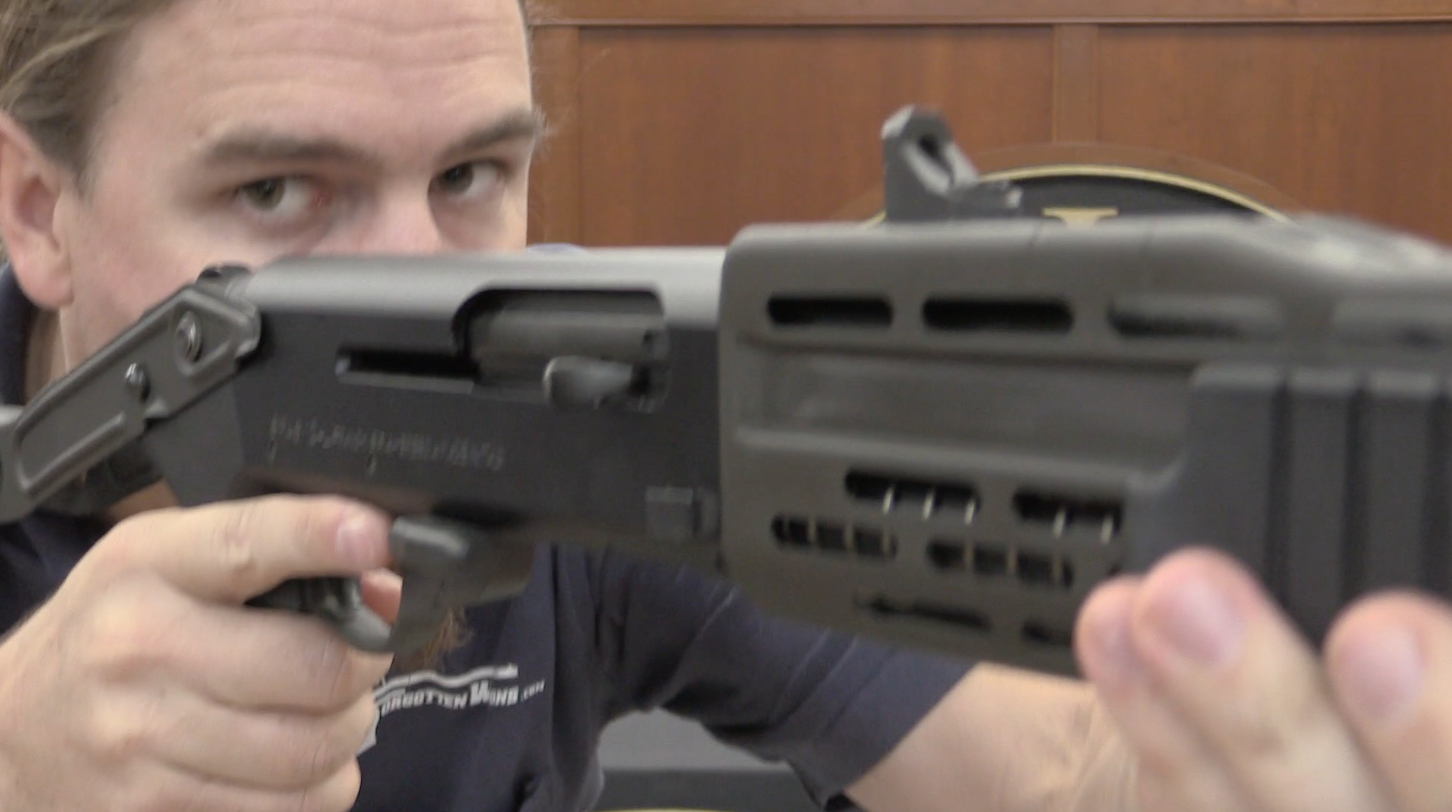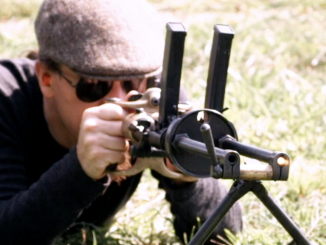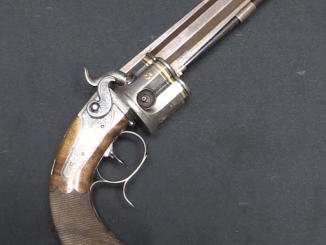In my opinion, the M38 Carcano as a very insightfully designed infantry rifle for World War Two, acknowledging the real-world use conditions of such weapons. With the M91/41 (aka M41), Italy took a step back from that. Originally designed as the M40 in 1940 with a new rear sight design adjustable out to a reasonable 500m, it was adopted in 1941 with a copy of the original M91 carbine rear sight, graduated out to 1000m. The barrel was shorter than the M91 rifle, but only by about 3.5 inches. It had a straight bolt handle, and sling attachments on both the side and the bottom.
The M41 was produced at the Terni Arsenal until September 1943, when Italy signed an armistice with the Allies. Production also took place at Armaguerra in the north, and that factory was controlled by German forces after the armistice, and would continue producing rifles in 1944. A total of about 917,000 M41 rifles were made between the two factories.




I think this rifle must be the revenge of the traditionalists. After the M38, someone must have decided that the way to go was to have a rifle with a long barrel, complicated sights and an awkward straight bolt handle. I’d love to know more about the thinking which led to this, it seems analogous to the Mosin 1891/30 in many ways.
Carbine sights to 1,000 meters (“these go to 11!”) but a 200-m battle sight is explicated–to my limited knowledge, without sources or attribution?–like Ian stated: Italian colonies in Libya and Eritrea and Somalia had very wide open spaces. So too the Russian Steppe. As we know, the Italians were roughly handled during Uranus and the encirclement of the besiegers of Stalingrad…
The 1891/30 analogy seems well taken: After the Russian Civil War, the victorious Bolsheviki decided to make the “Dragoon” length rifle the new standard. 48-1/2-inches 1232-mm instead of the even more ponderous M91 length of 51-inches. Perhaps a bit like the French decisions, n’est-ce pas? “First priority: A light machine gun.” Result? The excellent DP LMG “record player.” “Second priority: A new, state-of-the-art self-loading rifle” Result? the über-expensive and bugs-to-work-out SVT-38 and SVT-40. Then WWII comes to the USSR with Barbarossa: “Figure out how to produce literal mountains of the 1891/30 because the tooling exists for it, and it is a ‘known quantity’ while SMGs are similarly cranked out in prodigious quantities.”
So the 1891/30 might share a few similarities with the Berthier 07/15 in that regard? I mean the French kept the huge long barrel even though the svelte, much handier “short rifle” Tirailleur Indochinois version was available? Why no “short rifle” like the M1903, the M1907 SMLE, and by 1918 the Kar98a?
Is anyone aware of research that the longer barrel was retained because it offered a longer sight radius, and therefore some measure of inherent accuracy, particularly to soldiers not highly versed in marksmanship?
I ask, because it always struck me, contra the “garbage rod” vs. “fan-boy” debates, that while the Mosin-Nagant 1891/30 is unlovely, ungainly, ponderous, and subject to all manner of cludgy mishaps with the rimmed cartridge, the bolt that can seize, etc. etc. part of its North American “fan base” were simply delighted to actually hit what they were shooting at with it due to the sight radius?
Is there evidence–apart from hoary-old “what if the infantry have to fire in ranks?” “What if the infantry face a cavalry charge and need to fix bayonets and form a square?”ossified tactical doctrines–that longer barrels were retained for another reason?
I think the Italians realized that a non-adjustable 200m battle sight isn’t really good at hitting objects that tend to engage you at distances below 200m (i.e. attempting to stab you in the face) or machine-gunning you from distances beyond 200m. That aside, perhaps the M38 should have been redesigned with an adjustable rear sight. Perhaps the whole “did I get the 7.35mm version or the 6.5mm version” conundrum with the M38 production caused the higher-ups to order a new long rifle just to end the mess. I could be wrong.
“Why no “short rifle” like(…)M1907 SMLE(…)”
I assume M1907 means Mk. III in this place, if this does not hold true ignore this post entirely.
Notice 1891/30 was longer, but lighter than Mk. III – weighting 3,8 kg as opposed to 3,96 kg
Data from:
https://modernfirearms.net/en/military-rifles/bolt-action-rifles/russia-bolt-action-rifles/mosin-nagant-eng/
and
https://modernfirearms.net/en/military-rifles/bolt-action-rifles/great-britain-bolt-action-rifles/smle-lee-enfield-eng/
Thanks. Yes, I meant the Lee Enfield No.1 Mk.III. OK, so the weight is .16kg lighter by 5-1/2 ounces…
The point is that with its 17-in. bayonet permanently fixed a 1232-mm 48-1/2″ rifle is a bit long, even if almost a pound lighter than the m91 and fully 70-mm or 2-1/2 to 3″ shorter, vs., say, a 1132-mm/44.57″ Model 1907 No.1 Mk.III (100-mm shorter), let alone a 3.9kg/1100-mm U.S. M1903 Springfield “Roosevelt Mauser”, or even the 1110-mm long Kar98k.
Do you know if there are reasons cited in Soviet-era records about retaining the 1232-mm length? If so, what were the stated rationales?
Berthier 07/15: 1306-mm
Tirailleur Indochinois Mle. 1902 1125-mm France might have gone with the M1902 length in WWI. Did not. stuck with shorter carbines and 1306-mm 07/15.
Mosin-Nagant post Russian Civil War
1232-mm
1891/30: metic sights, minor changes in production methods and stock furniture–1232-mm
1939: M38 carbine 1013-mm because a mechanized army might need shorter, handier carbines for artillerists, drivers, etc. etc.
1943: M44 carbine–the “last bolt action rifle adopted by a major power?” 1013-mm corrects the only flaws found with the 1891/30 (excessive length) and M38 (no bayonet) for a new universal bolt-action carbine… The 7.62×41-mm, later 7.62×39-mm cartridge not far off when the SKS is adopted postwar…
Similarities:
France: “We cannot contemplate switching cartridges from 8×50-mmR Lebel while at war, we can only refurbish, rebuild the massive stock of M86/93 rifles and Berthier carbines, so let’s just adopt the Tirailleur Senegalais full-lenth Berthier as the new service rifle and crank it out in prodigious numbers, knowing that when war ends we can worry about a new cartridge and weapons to use it…” Unintended consequence: won the war anyway, improvisation during wartime worked, new rifle can take a back burner to more pressing issues: tanks, a new “super trench” even better than the late war Sigfried stellung/Hindenburg line in the permanent “ouvrages” and “fortiffs” of Maginot, and a new LMG, artillery, artillery, artillery. 7 different rifle designs at outbreak of WWII.
Russia: “We cannot contemplate switching to a self-loading rifle at the moment, which was slated to replace the long-in-the-tooth 1891/30 rifle, so as North Americans like to pretend Russians say ‘quantity has a quality all its own’ lets crank out the 1891/30 rifle while we perform the logistic feat of moving and rebuilding military industries out of the path of the Hitlerites and hasten to adopt improvisation and rational planning of phased, planned obsolescence–viz.: we can’t produce nothing but T-34s just yet, and car manufactories can produce ‘coffins for two brothers’ so put a 45-mm AT gun on it, call it the T70 and produce it, adopt the PPSh41, the 1891/30 is ‘good enough’–at least for now–and meanwhile begin planning to scrap the whole suite of small arms once the war is over…” Unintended result: truly staggering numbers of 1891/30s and lesser numbers of M44s, the latter which is then widely distributed after the war. 1891/30s repose in salt mines until post-Cold War surplus bonanza, “the last WWII rifle.”
“(…)Do you know if there are reasons cited in Soviet-era records about retaining the 1232-mm length? If so, what were the stated rationales?(…)”
I do not. I can only provide piece of Wikipedia article, which is abstract of V.G.Fyodorov from 1925:
https://ru.wikipedia.org/wiki/%D0%92%D0%B8%D0%BD%D1%82%D0%BE%D0%B2%D0%BA%D0%B0_%D0%9C%D0%BE%D1%81%D0%B8%D0%BD%D0%B0
В первые годы Советской власти развернулась широкая дискуссия по поводу целесообразности модернизации или замены имеющегося образца винтовки более совершенным. В её ходе был сделан вывод о том, что винтовка обр. 1891 года, хотя и уступая новым зарубежным аналогам, при условии ряда улучшений всё же вполне удовлетворяет имеющимся требованиям к данному виду оружия. Также было отмечено, что введение нового образца магазинной винтовки было бы по сути бессмысленно, так как сама по себе магазинная винтовка является стремительно устаревающим видом оружия, и затраты на разработку его принципиально нового образца были бы пустой тратой средств. Кроме того, отмечалось, что смена образца винтовки необходимо должна сопровождаться и сменой штатного винтовочного патрона на новый, лишённый недостатков существующего трёхлинейного, в частности, имеющий меньший калибр при большей поперечной нагрузке пули и гильзу без закраины — разработка полностью нового образца винтовки под устаревший патрон также расценивалась как не имеющая смысла. При этом состояние экономики, всё ещё выходившей из послереволюционной разрухи, отнюдь не давало поводов для оптимизма в отношении возможности такого масштабного перевооружения — как и предлагаемого Фёдоровым полного перевооружения Красной армии автоматической (самозарядной) винтовкой. Введение же самозарядной винтовки в дополнение к существующей магазинной сам Фёдоров считал бесполезным, так как получаемый при этом выигрыш в огневой мощи пехотного отделения был ничтожным — вместо этого он рекомендовал при сохранении магазинной винтовки текущего образца дополнить её большим количеством лёгких ручных (в его терминологии — «манёвренных») пулемётов вновь выработанного удачного образца.
That is:
In first years of Soviet power wide discussing was started regarding sense of updating or replacing current rifle with more modern. It was found that rifle model 1891, even despite inferiority to foreign rifle, after applying update, would full-fill all requirements towards this kind of weapon. It was also found that developing new repeating rifle do not make sense, as repeating rifle is aged kind of weapon and using resources to develop principally new one would be simply lose. Beyond that it was also found that new rifle should be developed for new cartridge – with lesser bullet diameter, greater perpendicular loading, rimless. At that time due to state of industry there was not much optimism for wide rearming. Fyodorov opposed idea of partial rearming[some soldiers totting repeating rifles, some soldiers totting self-loading rifles]as it do not provide gain in firepower, instead he proposed keeping repeating rifle as-is, but providing more LMG per unit of chosen successful machine gun
Note that this is point-of-view actual for year 1925.
“(…)We cannot contemplate switching to a self-loading rifle at the moment(…)”
There was wish for switching to self-loading, but it was challenging to design rifle which would be economical to make and immune to users with… questionable technical culture and yet not too heavy. Some competitors might be seen here:
http://www.earmi.it/armi/atlas2/617.htm
and here:
http://www.earmi.it/armi/atlas2/618.htm
It should be noted that in 1930 year, Soviets were actively seeking sub-machine gun, after this:
https://modernfirearms.net/en/submachine-guns/russia-submachine-guns/ppt-27-2/
proved not gun enough, so they might hoped to get shorter weapon for soldiers where weapon compactness was at premium
In the first years of Soviet power (e.g. 1925) broad discussions began regarding the desirablility of updating, or even replacing the current service rifle (i.e. Vintovka 1891) with a more modern design. It was found that rifle model 1891, even despite inferiority to foreign rifle designs (which one? the Mauser?), after applying updates (presumably eliminating the Konovalov rear sight in favor of a sturdier metric one?), would fullfill all requirements expected from this kind of individual weapon. It was also found that developing a new [manually operated surely?] repeating rifle did not make sense, as [the manually operated bolt-action] repeating rifle was an aged [obsolescent] kind of weapon and using resources to develop a substantially new one would be simply inefficient. Beyond that it was also found that not only a new rifle design should be developed, but also a new service cartridge – with a reduced bullet diameter (e.g. Fëderov’s 6.5-mm design), greater perpendicular loading [increased magazine capacity?], and a rimless case. At that time [1925 recall] due to the state of Soviet industry, there was not much optimism for such a complete rearmament project. Fyodorov opposed idea of partial rearmament as a half-measure [some soldiers toting [manually operated] repeating rifles,other soldiers toting self-loading rifles]as it would not provide substantive gain in firepower[.] Instead, he proposed keeping the repeating rifle as-is, but providing more LMGs per unit of chosen successful machine gun.”
MONEY. EFFORT. TIME. Thank you!
Contrasts with the 1920s French experience: The new cartridge is developed, namely, the 7.5×54-mm, and a new LMG the FM 1924/29 developed. Meanwhile, the 07/15 is replaced with the 07/16 with a five round magazine. In the USSR, the DP is the priority, the 7.62×54-mmR cartridge is retained. Fëderov’s desires to create a new service cartridge are ultimately quashed. The French want a self-loading rifle, but it has to be as reliable as the bolt-action service rifle. The decision is made to re-barrel and retrofit 8×50-mmR rifles for the new cartridge while also developing another manually-operated self-loading rifle in the new cartridge. This is the “road not taken” in the USSR. The retrofit of rifles already in inventory proves a “false economy” measure, but the rifles so modified are logically distributed. Finally, France adopts a bolt-action service rifle, emphasizing simplicity, robustness, and utter reliability.
The USSR rationalizes and updates the Mosin-Nagant with the 5-year plans, but retains the cartridge and rifle design while awaiting Tokarev’s deliverance from the late 19th century. The Tokarev rifle has too many bugs to work out, and it is enormously expensive. So the vintovka Mosina soldiers on as “good enough.”
“(…)greater perpendicular loading [increased magazine capacity?](…)”
This actually means greater force applied to the bullet inside barrel, this term is derived from fact that this value is estimated by multiplying powder gases pressure per area of perpendicular cross-section of bullet.
Maxim Popenker and Anthony G. Williams, _Assault Rifle_ (Crowood, 2004-2011), 10-11:
In 1930, the noted Russian gun historian, V.E. Markevich, then working at the Red Army’s Weapons Scientific and Research Range, suggested to the [Red] Army weapons command that:
The new ‘pistol carbines’ [SMGs] should not be built around pistol cartridges, because of range limitations, instead, such carbines should use a cartridge intermediate in power [aha! Fëderov!] between the pistol and rifle cartridges. It is ridiculous to simply shorten the current rifle cartridge case and use the current (7.62-mm) bullet for such cartridge, because of the rainbow-shaped trajectory and increased recoil. A true intermediate cartridge should be of 6.5-mm calibre, and such a cartridge is already available in the form of the American commercial .25 Remington cartridge [7.85g at 650m/s; 117gr. at 2,125ft/s]. The carbine for such a cartridge should be lightweight, have a magazine capacity of 20-30 rounds, and be effective at ranges of between 100-300 meters (109-330 yards].
To tie in with discussions of the 6.5×52-mm Carcano, the 6.5×50-mmSR Japanese, and 6.5×55-mm Swedish or 6.5×54-mm Mannlicher-Schönauer cartridges, that would be 6.35×52-mm/ .25 Remington.
I’m surprised you didn’t go down the CIA/Albania rabbit hole. It was an interesting sidenote of the rifle’s history.
I think your next book will be on Italian rifles. I picked this up when Chasspot to Famas was still in Kickstart days, near then end. The 6.5 bore being .268 has had alot(EVERYTHING) to do w/ American opinion of the rifle
How hard is it and how dangerous to convert an antique Carcano action to .308?
it’s a poor workman who blames his tools for shoddy work. italian rifles did not prevent rommel’s early success in north africa, nor did they have much to do with the german offensive into russia stalling within sight of the kremlin.
fact is, the italians fought and died. what more could they have done, except pick the correct side, and not to have been led by a meglomaniac.
If the king didn’t become such a pushover, then the fascist party and its stupid leader would not have received free reign over Italy! Just kidding…
I might add that Italians fought and died resisting said megalomaniac and his supporters and allies.
Darn civil wars…